
The Anaheim Convention Center was the venue for the Winter NAMM show in Anaheim, California on January 17th thru the
20th 2008. It was at this show that Ampeg unveiled their newest line of guitars. Labelled as the AMG100, it was significantly
different than it's predecessor, the AMG1.
As seen upper left, Bill Richardson as well as Dan's son and renowned pickup maker
Kent Armstrong grace the Ampeg booth posing for a photo with an early
AMG100 guitar. Given its black finish, black scratchplate, black matching truss rod cover and brown humbucking pickup - it would seem to suggest
that this particular guitar is most likely an early prototype.
At upper right, and having a little fun - Bill points out the Dan Armstrong name on Kent's shirt. No doubt he eventually got around to his
cap as well. With similar specifications to the 2006 ADA6 plexiglass reissue model, the AMG100 was available in three different models which was,
for the most part, a matter of three different choices of wood - which naturally relates to three different choices in price.
As seen upper left and right, the final shipping instrument that Bill and Kent were discussing above is the first guitar in the AMG100 lineup.
Called the 'AMG100 BK' it was the least expensive model which had a retail price of $599.99 at the time. Its lower price reflects the cost
savings of using an alder body that's finished in black. Alder is evenly textured, with a subdued grain pattern, and has a moderate weight and
hardness, but compared to more harder woods it is much easier to dent.
As seen at left, the eventual production model sports a tortoise-shell scratchplate. Ironically, my inside man at Ampeg back then informed me
"we were going to drop the tortoise scratchplate and truss rod cover in favor of all black but decided to keep the tortoise look."
This, to me anyway, supports my theory above - that Bill & Kent were holding a prototype model.
At right, and seen from the back, the neck attaches to the body as per the reissue Dan Armstrong lucite models, with four machine type bolts
with screwdriver type head slots that turn the bolts into threaded metal inserts, or T-Nuts. These T-nuts are anchored into the tongue of the
maple neck to accept the bolts. In the enlarged view, notice how the pickup set-screw is missing. Notice too, a strap peg is missing on the
bottom. I'm guessing that this was an intentional decision by a past owner.
At left, a better, clearer view of the tortoise-shell scratchplate. In the enlarged view, notice how the Wilkenson bridge is angled
relative to the tailpiece in order to get proper, or better intonation. This is just one of the adjustable features that's available
on this bridge. I like how both the 12th and 24th fret position markers made it into the photo. At right, and
better seen in the enlarged view - yet another model missing the pickup set-screw. On another note, and unlike the
AMG1 guitar, there is no inked-in serial number on the heel of the neck.
The AMG100 instruments had their serial numbers in a different location than the AMG1 guitars. Seen at left, notice the lack
of black paint in the instruments pickup cavity. As seen on the right, the reason behind this lack of black paint in the cavity
is because tape was put down prior to the body being finished in black and was lifted off afterwards. The instruments serial number
is located near the bottom of the pickup cavity, almost directly underneath the rear male banana jack.
Moving in closer - the guitars' serial number can be seen stamped into the wood body in this area. In the enlarged view the serial
number reads A32825D. The letter A is barely visible while the last letter 'D' is almost totally hidden. Only the beginning 'straight'
line of the D is visible, the rest being totally covered over by black paint.
Above left and right, an AMG100 BK on the workbench with the strings removed. Notice how this model sports volume and tone knobs with
black colored centers. It's unknown if these were stock, or if they were painted in by the owner.
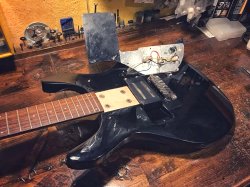
|
At left, with the scratchplate removed - the neck's tongue can be seen.
|
With the scratchplate fully turned over on this model, the shielding is seen covering only the back portion of the scratchplate, where
the electronics are located. Notice the two capacitors - one on each side of the selector switch with different values to them in order
to give different sounds. Lastly, notice the wires leaving the male banana plugs on the guitar and going to the controls.
At left, unlike most AMG instruments, this model sports what looks like a Gibson Tune-O-Matic bridge. However, upon closer look it
appears to be a TonePros bridge as it has those locking allen worm screws on it. I can only wonder if the owner didn't like the factory
Wilkinson roller style bridge that was stock to these instruments.
At right, Grover tuners were the stock tuners on all AMG100 guitars. Notice the maple neck, specifically the area just prior to where to the
headstock. Most, if not all have a curved transition in the wood like that as seen here. It is unknown whether this is a coincidence or part of
the manufacturing process but I've seen enough of them to believe it's the latter.
At left, and with the pickup removed, two sets of numbers can be seen. The serial number of the instrument is seen on the bottom of the
pickup cavity. In this photo, it's seen under the right banana jack. However, there is another number located dead center between the
two male banana plugs. In the enlarged view it reads '0712170426'. I can only speculate that this is a manufacturing number of sorts.
Also, on the body, notice the routing for the original tailpiece as well as the bridge - the latter with it's bushings in place. At right the
tongue of the neck is seen - anchored to the body with four T-Nuts of which are seen as well.
At left, the headstock, like everything else on the AMG100 maintains the shape of the Dan Armstrong plexis. There are some differences
however. Seen here the headstock features a matching gloss black finish like the body. Though shaped like the plexi models - the truss rod cover
matches the tortoise-shell look of the scratchplate. Lastly, and very much unlike the plexi models, the distinctive Ampeg 'a' adorns the upper
portion of the headstock. At right, and very much like the Dan Armstrong plexi models the AMG100 is equipped with a set of Grover Rotomatic
tuners on the hard rock maple headstock.
At left and right, Bill Richardson and Kent Armstrong at the 2008 Winter NAMM show discussing Ampeg's 'AMG100 CH' model. Here too, this is most
likely a prototype as it features the Dan Armstrong · Ampeg white lettering which stands out in sharp contrast on the
black scratchplate.
At upper left and right, the 'AMG100 CH' was Ampeg's intermediate version which had a retail price of $699.99 and sports a vintage
cherry finish with a laminated black scratchplate. The additional price reflects the use of its lightweight mahogany body. Like its acrylic
predecessor the fingerboards on these models are adorned with 3mm dot position markers. Notice by production time the
Dan Armstrong · Ampeg lettering is no longer seen on the scratchplate.
As seen upper left and right, mahogany is used by many major guitar makers as it produces a warm, mellow tone with excellent low frequencies,
pronounced lower-mids, and a smooth but subdued higher end. Naturally it's generally favoured for rock music among most. On all of the
photos above, notice the relatively straight grain which mahogany is well known for.
At upper left and right, the backside of the cherry model where the sculpting in the lower cutaway horn can be seen - just like the instrument
its styled after. At left, notice the virtually straight grain of the mahogany. These two have their respective pickup anchoring screws.
At left and like the black model, the serial number is stamped into the wood in the pickup cavity, hidden from view when a pickup is installed.
The serial number of this guitar reads A2687D. In the enlarged view the black-white-black laminates of the scratchplate can be seen just to the
upper right of the bridge. At right, and inked into the base of the necks tongue the actual date of manufacture can be seen. Like the black
model a long string of numbers are seen just above its serial number - whereas the black model shown above has this series of numbers located in
the pickup cavity. Again, I can only guess what these numbers represent - a factory product or routing number. Something along those lines maybe.
At upper left and right, the necks on the AMG100 models feature fingerboards of considerable thickness.
At left, the AMG100 CH models have a rather interesting headstock that the other two seem to lack. Although styled the same, the CH model often
features a headstock veneer that's a bit different than that of the body. Seen here in a more natural mahogany looking veneer, it looks nothing
like the cherry red finish of the body. The black-white-black laminated truss rod cover does match the instruments scratchplate however.
At right, and seen from the backside is another rather interesting anomaly - and one which is shared by all three models. The tuners on these
models are Grover nickel die-cast. While it's nice to see a good set of quality tuners on any guitar - one has to question the logic of nickel
plating when the rest of the hardware on these instruments are chrome plated. Although dark, notice the 'Made in China' sticker near the bottom.
At upper left, another AMG100 CH model but as can be seen here, this one features a black veneer on the headstock. The signature Ampeg 'a'
really pops set against all that black. Notice that the laminated truss rod cover still has its plastic protective cover on. At right, the
nickel-plated Grover tuners adorn the headstock - you can make out that a cell phone was used to take the photo - pretty good camera he has on
that phone! Again, notice the Made in China sticker.
So the question naturally arises - why are some of the AMG100 CH models equipped with such different veneers on their headstocks? Unfortunately,
one can only speculate, and I cannot help but wonder if some necks made for the black alder version were (for whatever reason) grabbed, whether
intentionally, or accidentally, at the factory being the necks were otherwise identical. As for the models that employ the natural mahogany
looking wood veneer I'm afraid I don't even have a theory. Maybe to match the rosewood fingerboard? It would seem unlikely.
Above left, apparently someone took the tortoise-shell scratchplate from a black alder model and installed it onto this cherry model. At right
it gets even more confusing as I pretty much expected the truss rod cover to be of the same tortoise-shell look - just like the black models
feature. Instead, this guitars black veneered headstock now features what I first thought was a black truss cover of a totally different shape.
But upon further investigation and using some image enhancing I was able to figure it out. In the enlarged view, you can barely make it out but
it is, in fact - a matching black Dan Armstrong cover - perhaps one from an AMG BLD headstock perhaps. Oddly enough, if you look close you will
see the cover has been put on in reverse. Perhaps the bottom two screws line up with the holes in the headstock? I can't honestly say as I've
never tired it before.
Above left, and right, pulling a black ST pickup out of the pickup cavity on A2687D. Like the acrylic models, these instruments feature the
unique interchangeable pickup design. The ST is the stock pickup for these models and were molded in black. At right, the ST humbucker from the
bottom. Notice how it looks different from the bottom of the Dan Armstrong acrylic model pickups made years prior. Years ago Kent Armstrong told
me about his (then) new process for making these pickups which was to use pre-made rectangular 'cups' (for lack of a better word) and then place
the coil within its center. Once centered and tied in the resin is added which totally isolates the coil from virtually everything. Simply put,
they are some of the most, if not thee most potted pickups ever produced.
Above left and right, the AMG100 instruments all shipped in TKL cases like the acrylic models.
As seen above left, the last instrument in the lineup is the AMG100 BLD. With a suggested retail price of $949.99 - it's higher price reflects
the higher grade woods that were used. Over on the right, the lightweight swamp ash body sports a semi-transparent vintage blonde finish.
At left, and like the other models in this line, the 243/4" scale neck features a 24-fret fingerboard. Unique to this model is the
presence of a mahogany strip running down its center in the Fender style fashion. As seen at right, because these models are built to the same
specifications as the Dan Armstrong acrylic models the necks are bolted to the body in the same fashion. This unique neck joint permits easy
access to two full octaves of playability.
Users state that the neck is relatively slim and a perfect fit for those with smaller hands. Its shape moves from a curved 'C' shape at the
first fret and gradually flattens out towards the 12th fret and beyond. Being a short scale neck - it helps give this guitar
additional warmth and depth - given the brightness of the woods chosen for this model.
At left, the AMG100 models all feature a 3-way tone switch does a good job of getting the most out of a single pickup design. Electrically, it
operates just like the switch on the Dan Armstrong acrylic models. In the center position, the tone control is bypassed so the signal goes
straight from the volume pot directly to the instruments' output jack. With the switch in the up position the tone control works like that on
most other guitars - when turned forward, it increases the higher frequencies, while turning the tone control backwards reduces the higher
frequencies. With the switch in the lower position - the frequency response of the tone pot can be pre-set at a particular frequency. Depending
where the knob is turned it can emulate a multitude of sounds, all set to go at the flick of a switch. One interesting setting makes for an
interesting compressed sound like that of a cocked wah-pedal. Notice the bevelling on the edges of the scratchplate. At right, the AMG100 models
all employ a chrome plated
Wilkinson
tunable brass roller bridge and tailpiece.
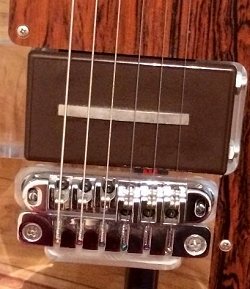
|
As seen at left, the details are unclear as to the how's and why's - but the very same Wilkinson bridge and tailpiece used on the AMG100 models
was, or soon would be, replacing the original tailpiece and rosewood saddle bridges on the 2008 and later made Dan Armstrong acrylic models.
The Wilkinson bridge allows for perfect intonation by utilizing grub screws to lock everything into place once it's all dialed in. Hopefully
it will serve to eliminate modifications to these later made instruments.
|
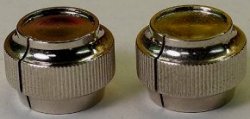
|
These guitars are equipped with retro style volume and tone knobs. While the styling is identical to the original acrylic instruments from the
60's and 70's the materials they are made of are different. Whereas the originals were made of aluminum the AMG100 knobs,
like the AMG1 and AMB1 instruments are plastic and covered in a nickel type plating.
|
At left, the headstock for the AMG100 BLD matches the maple neck and fingerboard, while the single-ply black truss rod cover is of the same
material as the scratchplate. Here to, my inside contact at Ampeg at the time informed me that "We were going to drop the blonde headstock
in favor of all black but decided against any changes." Apparently someone at Ampeg felt that, like the other two models in the AMG lineup
- the headstock model should match the scratchplate as well.
From the back, the mahogany filler strip can be seen. Further up, the backside of the headstock features a set of nickel Grover die cast tuners,
which are positioned for nearly direct string pull while being close-coupled for minimum string tension differences.
At left and right, like the cherry model seen further above, a different type of scratchplate adorns this BLD model. But unlike the
aforementioned model, this scratchplate is not from within the AMG100 camp at all. This faux-wood scratchplate was almost certainly pulled off
a newer acrylic Dan Armstrong guitar,
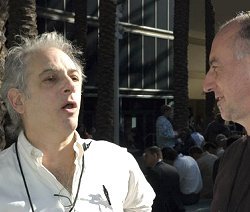
|
At left, another person present at the Winter NAMM show that Bill Richardson spoke with was none other
than Matt Umanov
who created the original prototype acrylic guitar and bass models back in 1968. Although Dan Armstrong had the basic idea
Matt would come to contribute just as much when it came to their design - as Dan turned to him for his advice on
nearly every aspect of the instruments.
From the onset, Matt cleaned up Dan's drawing of the body shape, then added beveled contours to the acrylic body. He then suggested the use
of quarter-sawn woods for the neck & fingerboard and is equally credited for the use of small position markers on the fingerboard.
|
It was Matt who suggested the change of the headstock shape, as well as the eventual clean up lines to the headstock. It was Matt who
suggested the use of Schaller tuners and ivory nuts - the latter of which Matt provided from his own stock of ivory. All this and more supports
the fact that the Dan Armstrong acrylic guitars and basses are as much a product of Matt Umanov as they are of Dan Armstrong. So it was only
natural, then, for him to stop by the Ampeg booth to see these wooden versions of his and Dan's creation and visit with everyone.
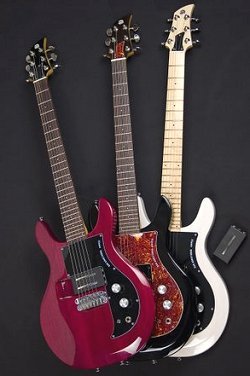
|
Seen at left, the AMG100 CH, BK & BLD. models. Notice that all three models sport the Dan Armstrong · Ampeg name on their
scratchplates which suggests they are prototypes. It is unknown for sure why the name was dropped, perhaps just to keep them differentiated from
the acrylic models.
Unlike the AMG1 instruments which were made in Japan by Fujigen, the AMG100 instruments were manufactured in China at the Chinese Grand Reward
factory. Although they're essentially a wooden-bodied version of the Dan Armstrong acrylic instrument, (like the AMG1) the devil is in the
details - and for many Dan Armstrong aficionados these details are what set them apart from the former AMG1 model, and significantly more like
the Dan Armstrong acrylic guitar.
For these aficionados, or anyone else wanting a Dan Armstrong guitar but don't want the weight, or the higher price tag of acrylic, the AMG100
models have served as an excellent alternative for many.
|
On May 10th 2018 the Yamaha Guitar Group acquired Ampeg from LOUD Audio. The press release can be read
here.
Commonly called 'Yampeg' by many since, fans of
these instruments are petitioning Yamaha to 'Bring Back the Ampeg AMG100' at change.org. You can read, and sign the petition
here if you like.
menu
Names and images are TMand © Dan Armstrong / Ampeg. All rights reserved.
All other names and images are TMand © of their respective owners. All rights reserved.
|
| |

